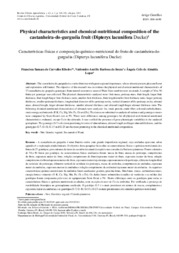Physical characteristics and chemical-nutritional composition of the castanheira-do-gurguéia fruit (Dipteryx lacunifera Ducke).
Physical characteristics and chemical-nutritional composition of the castanheira-do-gurguéia fruit (Dipteryx lacunifera Ducke).
Author(s): RIBEIRO, F. S. de C.; SOUZA, V. A. B. de; LOPES, Â. C. de A.
Summary: The castanheira-do-gurguéia is a native fruit tree with great regional importance, whose almond present pleasant flavor and exploration still limited. The objective of this research was to evaluate the physical and chemical-nutritional characteristics of 23 castanheira-do-gurguéia genotypes from natural occurrence areas of Piauí State southwestern savannah. A sample of 30 to 50 fruits per genotype was collected. The physical characteristics analyzed were: fruit mass, pericarp mass, fruit length, larger fruit thickness, fruit length/larger fruit thickness ratio, smaller fruit thickness, fruit length/smaller fruit thickness ratio, larger pericarp thickness, smaller pericarp thickness, longitudinal diameter of the pericarp cavity, vertical diameter of the pericarp cavity, almond mass, almond length, larger almond thickness, smaller almond thickness and almond length/larger almond thickness ratio. The following chemical-nutritional characteristics of almonds were analyzed: fat, crude protein, crude fiber, ash total carbohydrates, crude energy and minerals (P, K, Ca, Mg, Mn, Fe, Cu and Zn). The data were submitted to analysis of variance and genotypes means were compared by Scott-Knott?s test at 5%. There were differences among genotypes for all physical and chemical-nutritional characteristics evaluated, except Ca in the almonds. It was verified the presence of great phenotypic variability in the analyzed germplasm. The genotype G-3 is the most promising in terms of almond mass, almond length and larger almond thickness, and the genotypes G-7, G-10, G-13 and G-23 are the most promising in the chemical-nutritional composition.
Publication year: 2012
Types of publication: Journal article
Unit: Embrapa Mid-North
Keywords: Cerrado piauiense, Genética Vegetal, Noz
Observation
Some of Embrapa's publications are published as ePub files. To read them, use or download one of the following free software options to your computer or mobile device. Android: Google Play Books; IOS: iBooks; Windows and Linux: Calibre.
Access other publications
Access the Agricultural Research Database (BDPA) to consult Embrapa's full library collection and records.
Visit Embrapa Bookstore to purchase books and other publications sold by Embrapa.

